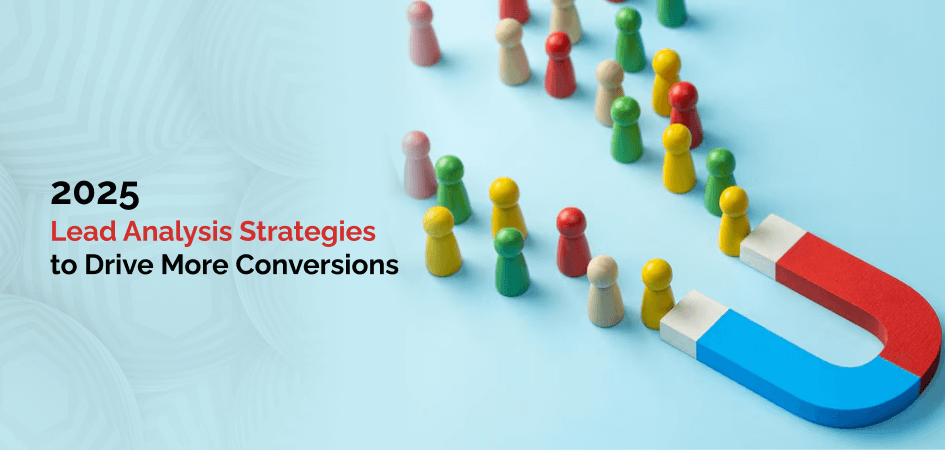
Businesses’ methods for locating and converting leads are always changing. In 2025, new technologies, data sources, and AI-driven conclusions will make lead analysis more important than ever. Lead analysis involves more than just collecting names and emails. It investigates the identities, routines, and motivations of your potential customers.
You can improve your marketing, increase consumer interest, and convert more leads into customers by utilizing intelligent lead analysis solutions. In order to assist you in analyzing your leads and boosting conversion rates in 2025, we’ll outline specific, achievable techniques in this piece.
What Is Lead Analysis?
Lead analysis is the process of examining data about your prospects to identify their needs, interests, and purchasing readiness. It differs from lead generation. It is not the same as lead generation, which focuses on making new connections. Lead analysis takes those contacts and scores, segments, and tracks them through your sales funnel.
Lead analysis sits at the heart of both marketing and sales. Marketers use it to tailor messages and offers. Sales teams use it to prioritize outreach. Together, they turn raw leads into paying customers.
- Lead Generation : Collects names, emails, and basic info through forms, ads, or events.
- Lead Analysis : Studies that use data along with behavior, demographics, and engagement to predict who will convert.
Importance of Lead Analysis in 2025
- Data‑Driven Decisions
With more data than ever, gut instinct isn’t enough. Lead analysis helps you spot trends and make choices backed by real numbers.
- Personalized Buyer Journeys
Shoppers expect messages that match their needs. By analyzing lead behavior, you can send the right offer at the right time, whether it’s a product demo, a discount, or a case study.
- Improved ROI on Campaigns
When you know which leads are most likely to convert, you spend less on unqualified prospects. That means a higher return on every ad dollar and email campaign.
- Staying Competitive in AI‑Powered Markets
AI tools are becoming common in marketing. If you can’t analyze leads quickly and accurately, you’ll fall behind competitors who can.
Key Metrics to Track for Lead Analysis
To get the most from your lead data, focus on these metrics:
- Lead Source & Channel Performance
Which channels social, email, search, referrals bring your best leads? Track cost per lead and conversion rate by channel.
- Engagement Level
Measure clicks, email opens, time on page, and form completions. Higher engagement often signals stronger interest.
- Lead Qualification Score
Use a scoring model that assigns points based on actions (e.g., downloaded a guide = 10 points; requested a demo = 50 points). Higher scores mean higher priority.
- Conversion Rate by Lead Type
Compare how different types of leads convert. For example, webinar attendees vs. ebook downloaders.
- Customer Lifetime Value (CLV) Predictions
Estimate how much a customer will spend over their lifetime. Focus on leads with the highest potential value.
Advanced Strategies for Lead Analysis
1. AI & Machine Learning for Predictive Lead Scoring
Modern platforms use AI to spot patterns that humans might miss. They analyze past deals to predict which new leads will convert. This helps you focus on high‑value prospects.
2. Behavioral Segmentation for Targeted Nurturing
Group leads by actions pages visited, emails opened, videos watched. Then, send tailored content to each group. For example, leads who watch a product demo video get a case study next.
3. Heatmaps & Session Recordings
Tools like Hotjar show where users click, scroll, or get stuck. This insight helps you improve landing pages and forms to boost conversions.
4. Integrating CRM & Analytics Tools
Connect your CRM (e.g., Salesforce, HubSpot) with analytics platforms (e.g., Google Analytics 4). This gives a unified view of lead activity and sales outcomes in one dashboard.
5. Using Attribution Models to Assess Lead Sources
Move beyond last‑click attribution. Use multi‑touch models (first click, linear, time decay) to see how each channel contributes to conversions. This helps you allocate your budget more wisely.
Tools and Platforms for Lead Analysis
Here are the top tools to power your lead analysis:
- HubSpot : All‑in‑one CRM with built‑in lead scoring, segmentation, and reporting.
- Salesforce : Enterprise CRM with AI‑driven Einstein Analytics for predictive scoring.
- Google Analytics 4 : Tracks user behavior across web and app with enhanced event tracking.
- Hotjar / Crazy Egg : Heatmaps and session recordings to optimize pages.
- Segment / Tealium : Customer data platforms that unify data from multiple sources.
Integration Tips:
- Sync your CRM with your email and ad platforms for complete data flow.
- Use APIs or native connectors to keep data fresh and accurate.
- Create dashboards that display important metrics quickly.
Common Mistakes to Avoid
- Relying on Vanity Metrics : High traffic or email opens look good but don’t always lead to sales. Focus on actions that predict conversions.
- Ignoring Post-Conversion Behavior : By monitoring only until the sale, upsell opportunities and churn signals are missed.
- Lack of Cross‑Channel Attribution : Treating each channel separately can mislead your budget decisions.
- Not Aligning with Sales Teams : If marketing and sales use different definitions of a qualified lead, you waste time and resources.
How to Turn Insights into Action
- Create Lead Segments
Use your scoring and behavior data to group leads (e.g., hot, warm, cold). Tailor campaigns for each group.
- Optimize Content & CTAs
Test headlines, form fields, and calls to action. Use A/B testing to find what drives the best engagement.
- Align Sales & Marketing Workflows
Define clear handoff criteria. When marketing qualifies a lead, notify sales with all relevant data (score, behavior, source).
- Run A/B Tests Based on Analysis
Test landing page layouts, email subject lines, or ad copy. Let your data guide each experiment.
Conclusion
Lead analysis is the key to smarter marketing and higher conversions in 2025. By using advanced technologies, monitoring the appropriate KPIs, and staying clear of typical mistakes, you can focus on the leads that matter most.
Align your teams, connect your audience, improve your content, and translate your findings into actionable recommendations. Keep measuring, testing, and refining. With these strategies, you’ll boost ROI, personalize buyer journeys, and stay ahead in a data‑driven world. Start your lead analysis journey today, and watch your conversions climb.

I bring a wealth of knowledge and experience to WillShall Consulting with two decades of expertise in Website Design, Development, and Digital Marketing, My journey has been marked by a passion for creating innovative web solutions that not only meet but exceed client expectations. As an avid analyst, I dedicate myself to understanding each customer’s unique needs, ensuring that our web solutions are not just functional but exceptional.









